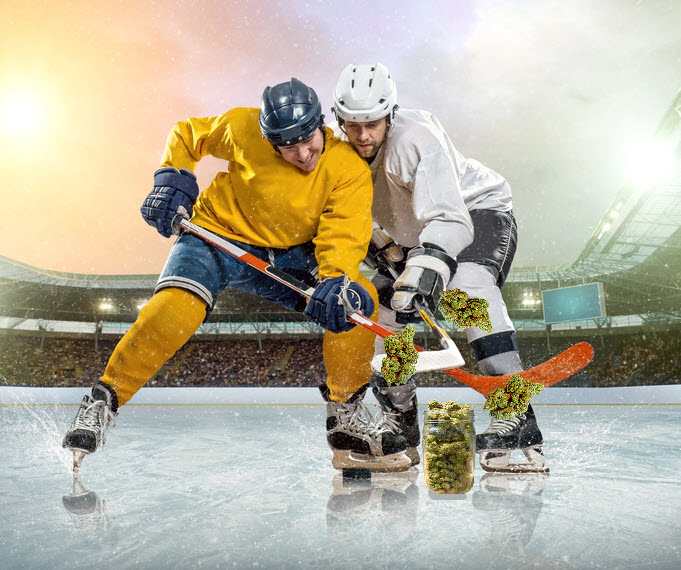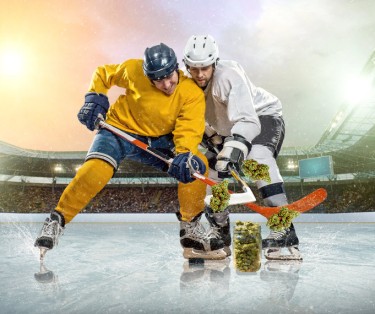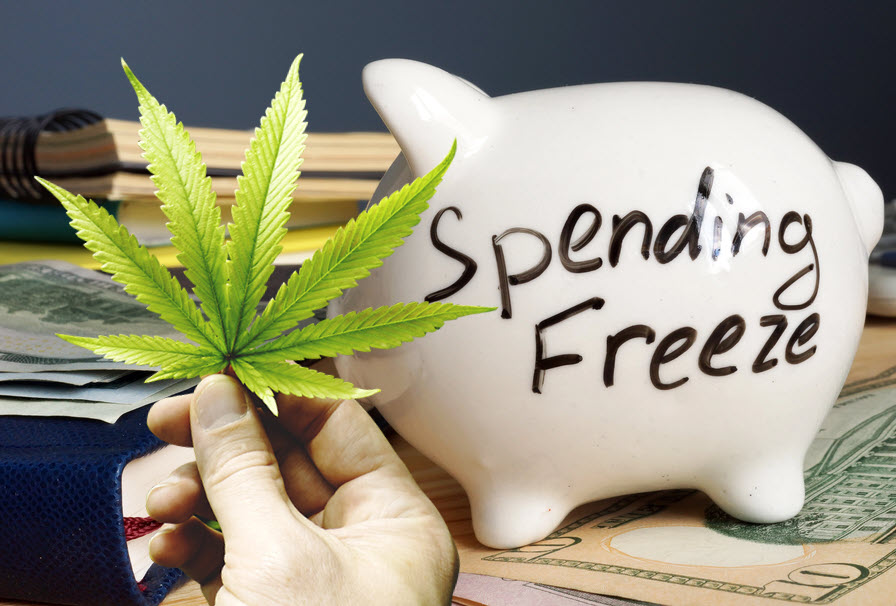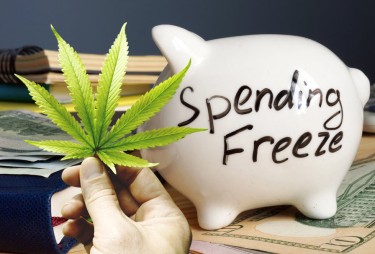Cannabis News
If You Smoke Weed around Your Kids, Will They Test Postive for THC?
Published
6 days agoon
By
admin

The legalization and decriminalization of cannabis in many parts of the world have sparked widespread debate about its societal, medical, and personal implications. While much of the focus has been on adult usage and its effects, an often-overlooked issue is how secondhand cannabis smoke impacts children living in homes where the drug is consumed. Recent research has revealed that children exposed to cannabis smoke in their homes are at risk of testing positive for tetrahydrocannabinol (THC), the psychoactive compound in cannabis. This finding raises significant concerns about the health, safety, and developmental outcomes for these children.
In this article, we will delve into the findings of recent studies, explore the potential health risks associated with secondhand cannabis smoke, and discuss broader social and legal implications. We will also examine how parents and caregivers can mitigate these risks to protect children from inadvertent exposure.
The Science Behind Secondhand Cannabis Smoke
Secondhand smoke refers to the involuntary inhalation of smoke exhaled by a smoker or released from a burning substance. While tobacco secondhand smoke has been extensively studied and linked to numerous health issues, secondhand cannabis smoke is a relatively new area of research. Cannabis smoke contains many of the same harmful chemicals as tobacco smoke, including carcinogens, fine particulate matter, and respiratory irritants. However, cannabis smoke also contains cannabinoids like THC and cannabidiol (CBD), which can have psychoactive or physiological effects when absorbed into the body.
When cannabis is smoked indoors or in enclosed spaces, it creates an environment where non-smokers, including children, can inadvertently inhale these substances. Unlike adults who may choose to avoid such environments, children are particularly vulnerable because they lack agency over their living conditions and are often in close proximity to their caregivers.
Recent Research Findings
A groundbreaking study conducted in San Diego County, California, examined whether children living in homes where cannabis is smoked test positive for THC exposure. Researchers collected urine samples from children aged 0 to 13 years who were brought to pediatric clinics for routine care. Caregivers were also surveyed about their cannabis use habits, including whether they smoked indoors or outdoors.
The results were striking: children living in homes where cannabis was smoked had five times higher odds of testing positive for THC compared to those living in non-smoking households. This finding indicates that secondhand exposure to cannabis smoke is not just a theoretical risk but a measurable reality.
Key Findings
-
THC Detection: Detectable levels of THC metabolites were found in the urine samples of children exposed to secondhand cannabis smoke. This suggests that even passive exposure can lead to absorption of psychoactive compounds into a child’s system.
Health Risks Associated with Secondhand Cannabis Smoke
The presence of THC metabolites in children’s systems raises serious concerns about the potential health risks they face. While research on this specific topic is still emerging, existing studies on secondhand tobacco smoke and direct cannabis use provide valuable insights.
1. Respiratory Issues
Cannabis smoke contains fine particulate matter that can irritate the respiratory system. Prolonged exposure may lead to:
-
Increased risk of asthma attacks
-
Chronic bronchitis or other respiratory conditions.
-
Reduced lung function over time.
Children’s lungs are still developing, making them particularly susceptible to damage from inhaled irritants.
2. Cognitive and Developmental Concerns
THC is known to affect brain function by interacting with cannabinoid receptors in the central nervous system. While most studies focus on direct cannabis use during adolescence or pregnancy, there is concern that even low-level exposure through secondhand smoke could impact brain development in young children.
Potential risks include:
-
Impaired memory and learning abilities.
-
Delayed cognitive development.
-
Behavioral issues such as hyperactivity or attention deficits.
3. Chemical Exposure
In addition to THC, cannabis smoke contains harmful chemicals such as ammonia, hydrogen cyanide, and polycyclic aromatic hydrocarbons (PAHs). These substances are known carcinogens and can increase the risk of cancer over time.
4. Psychoactive Effects
Although rare, there have been anecdotal reports of children experiencing mild psychoactive effects after significant exposure to secondhand cannabis smoke. Symptoms may include drowsiness, confusion, or changes in mood.
Broader Implications
The findings about children’s exposure to secondhand cannabis smoke have far-reaching implications that extend beyond individual households. They touch on public health policies, legal frameworks, and societal attitudes toward cannabis use.
1. Public Health Concerns
As more states and countries legalize recreational and medicinal cannabis use, public health agencies must address the unintended consequences for vulnerable populations like children. Educational campaigns similar to those targeting tobacco use may be necessary to raise awareness about the risks of secondhand cannabis smoke.
2. Legal Considerations
In some jurisdictions, exposing children to harmful substances like tobacco or drugs can be considered child endangerment. As evidence mounts about the risks of secondhand cannabis smoke, lawmakers may need to consider whether similar protections should apply.
For example:
These are complex questions that balance individual freedoms with societal responsibility for child welfare.
3. Social Stigma vs Awareness
Cannabis use has historically been stigmatized due to its association with illegal activity. While legalization aims to reduce stigma and promote responsible use, it is crucial not to overlook potential harms—especially those affecting children who cannot advocate for themselves.
Recommendations for Parents and Caregivers
Parents who use cannabis should take proactive steps to minimize their children’s exposure:
The Need for Further Research
While current studies provide valuable insights, much remains unknown about the long-term effects of secondhand cannabis smoke on children’s health and development. Future research should focus on:
-
Longitudinal studies tracking exposed children over time.
-
The impact of different levels of exposure (e.g., occasional vs frequent).
-
Interactions between secondhand tobacco and cannabis smoke.
-
Effective interventions for reducing childhood exposure.
Conclusion
The revelation that children living with cannabis smokers can test positive for THC underscores an urgent need for greater awareness and precautionary measures among parents and caregivers who use cannabis. These findings highlight how changing attitudes toward drug use must be accompanied by thoughtful consideration of its unintended consequences—particularly for vulnerable populations like children. As society continues to navigate the complexities surrounding cannabis legalization, protecting children’s health must remain a top priority. By fostering open dialogue, promoting education, and implementing evidence-based policies, we can ensure that progress in one area does not come at the expense of another generation’s well-being.
CANNABIS AROUND KIDS, WHAT ABOUT SURGING ASTHMA? READ ON…
IS CANNABIS CAUSING A SURGE IN KIDS’ ASTHA CASES IN LEGAL STATES?
You may like
-


The Best Thoughtful And Inexpensive Valentine’s Day Gifts
-


5 Ideas To Have A Fun Single’s Valentine’s Day
-


Snoop, Wiz, Lil Baby’s latest: Top celeb weed for 2025
-


Hockey Players Ditching Post Game Beers for Cannabis Edibles and Playstations
-


The Best Marijuana Strains For Valentine’s Day
-


Ventura Hall of Flowers is March 19–20—is your business ready?
Cannabis News
Hockey Players Ditching Post Game Beers for Cannabis Edibles and Playstations
Published
12 hours agoon
February 12, 2025By
admin

The landscape of professional sports is constantly evolving, and the National Hockey League (NHL) is no exception. In recent years, a noticeable cultural shift has taken place within the league, as players increasingly turn away from traditional post-game celebrations centered around alcohol. Instead, they are embracing alternative forms of relaxation and entertainment, such as edible cannabis and video gaming. This trend reflects broader societal changes regarding health, wellness, and leisure activities, particularly among younger generations.
In this article, we will explore the factors contributing to this transformation in the NHL, examine its implications for players and the league, and consider what this means for the future of professional hockey.
A Changing Culture in Professional Sports
The Traditional Post-Game Scene
For decades, professional athletes have celebrated victories and coped with losses in locker rooms and bars with alcohol. The camaraderie built during these moments has been an integral part of team culture. However, with increasing awareness of the negative effects of excessive drinking—both on health and performance—many players are reconsidering their choices.
Rise of Health Consciousness
The shift away from alcohol consumption can be attributed to a growing emphasis on health and wellness in sports. Athletes today are more aware than ever of the importance of maintaining peak physical condition. With advancements in sports science and nutrition, players are focusing on optimizing their performance through better lifestyle choices.
In interviews, several NHL players have expressed their commitment to healthier living. For instance, Toronto Maple Leafs forward Mitch Marner has spoken about how social media has changed the way athletes engage with nightlife. “It’s different now,” he said. “You don’t want to be out there partying when you know everyone is watching.” This increased scrutiny has made players more cautious about their public personas.
The Emergence of Edible Cannabis
Legalization and Acceptance
One significant factor contributing to the rise of edible cannabis among NHL players is the changing legal landscape surrounding marijuana use. As more states in the U.S. and provinces in Canada legalize cannabis for recreational use, athletes feel more comfortable exploring its benefits without fear of repercussion.
The NHL has historically taken a hard stance against substance abuse; however, its policy on cannabis has evolved. The league no longer suspends players for positive tests related to marijuana use, recognizing its potential therapeutic benefits for pain management and recovery.
Therapeutic Benefits
Many players have turned to cannabis as a natural alternative to traditional painkillers or anti-inflammatory medications. Edible cannabis products offer a discreet way to consume THC without the stigma associated with smoking. Players report using these products to help with anxiety, sleep issues, and recovery from injuries.
For example, former NHL player Riley Cote has become an advocate for cannabis use in sports after his own experiences with pain management during his career. Cote emphasizes that cannabis can provide relief without the side effects associated with opioids or alcohol.
Video Gaming: A New Form of Socialization
Alongside the shift towards edible cannabis is the growing popularity of video games among NHL players. Esports have exploded in popularity over the last decade, providing a new avenue for social interaction and competition among athletes. Many players now spend their downtime playing video games together online rather than heading out for drinks.
This trend has been particularly pronounced during the COVID-19 pandemic when social distancing measures limited traditional forms of entertainment. Players found solace in gaming communities where they could connect with teammates and friends while staying safe at home.
Video gaming has also become a tool for building team chemistry. Many NHL teams now incorporate gaming sessions into their training regimens, allowing players to bond over shared interests outside of hockey. This informal setting fosters communication and teamwork skills that can translate into better performance on the ice.
Players like Nashville Predators’ Matt Duchene have spoken about how gaming helps them unwind while still maintaining a competitive edge. “It’s a great way to relax after games,” Duchene noted. “You can connect with guys without having to go out.”
The Impact on Player Relationships
As drinking culture declines within the NHL, player relationships are evolving as well. While alcohol often served as a social lubricant that brought teammates together after games, alternatives like gaming and cannabis are fostering new connections based on shared interests rather than shared drinks.
This shift may lead to deeper bonds among players who engage in activities that promote teamwork and camaraderie without the potential pitfalls associated with alcohol consumption. Players are finding new ways to support each other both on and off the ice.
The focus on healthier lifestyles also aligns with growing awareness around mental health issues in sports. Many athletes face immense pressure to perform at high levels, which can lead to anxiety and stress. By prioritizing mental well-being through alternative relaxation methods like gaming or cannabis use, players may find healthier coping mechanisms that contribute positively to their overall mental health.
League Response and Future Implications
The NHL’s evolving stance on cannabis reflects broader societal changes regarding its acceptance. As more research emerges about its benefits for athletes, it is likely that we will see further integration of cannabis into player wellness programs.
The league’s leadership has acknowledged these shifts by allowing teams to educate players about responsible cannabis use while also promoting healthy lifestyles overall. This proactive approach may help reduce stigma around cannabis use within professional sports.
As video gaming continues to gain traction among NHL players, teams may explore ways to incorporate technology into their training regimens further. Virtual reality (VR) training sessions or gamified drills could enhance player development while catering to their interests outside traditional practice methods.
Additionally, partnerships between NHL teams and gaming companies could lead to innovative fan engagement strategies that bridge the gap between hockey and esports communities.
Conclusion
The cultural shift within the NHL signifies a notable change from traditional post-game celebrations, as players increasingly favor healthier alternatives like edible cannabis and video gaming over alcohol, redefining how they celebrate victories and bond as teammates. This transformation reflects evolving attitudes towards health and underscores the growing emphasis on mental well-being in professional sports, with players prioritizing self-care through modern relaxation methods, thereby setting a precedent for future generations to follow. The NHL now stands at a pivotal moment where it can either hold onto outdated practices or embrace a new era that values player health and fosters deeper connections among teammates both on and off the ice; clearly, the trend is moving away from alcohol consumption towards integrating healthier options into the culture of professional hockey.
CANNABIS FOR SPORTS FANS, READ ON…
FIFA WANTS YOU TO SMOKE WEED AND NOT DRINK FOR THE WORLD CUP!
Cannabis News
How Does DOGE and the Federal Funding Freeze Impact the Cannabis Industry?
Published
1 day agoon
February 11, 2025By
admin

The cannabis industry, a burgeoning sector with significant economic potential, operates in a complex landscape shaped by evolving state regulations and persistent federal prohibition. Recent events involving a temporary federal funding freeze have highlighted the vulnerability of this industry, particularly for Indigenous communities actively involved in its development. While the immediate crisis was averted, the episode served as a stark reminder of the precariousness of relying on federal support and the urgent need for self-sustaining revenue models.
In late January 2025, the White House’s Office of Management and Budget (OMB) issued a memo calling for a temporary pause on payments for federal grants and other programs[1][4]. This decision, stemming from an executive order by then-President Trump, triggered widespread confusion and anxiety across various sectors, including housing, education, and nonprofits[1]. The Native American Rights Fund (NARF) quickly issued a statement emphasizing the disproportionate impact such a freeze would have on Tribal Nations. Fortunately, the Trump administration rescinded the memo just two days later, following a temporary pause on implementation by a federal judge. Another judge followed suit with a restraining order.
While the immediate threat was neutralized, the incident exposed the inherent risks associated with federal funding dependence, particularly for Indigenous communities striving to establish themselves in the cannabis industry. The Indigenous Cannabis Industry Association (ICIA), an organization uniting Native American tribes around the cannabis plant, released a statement addressing the situation and its implications.
Disproportionate Impact on Indigenous Communities
The ICIA’s founder, Rob Pero, a member of the Bad River Ojibwe and founder of Canndigenous, Wisconsin’s first independent Indigenous-owned hemp company, emphasized the disproportionate impact of a federal funding freeze on Indigenous communities. “The threat of a federal funding freeze has a disproportionate impact on Indigenous communities, exacerbating existing economic disparities,” Pero told Forbes. He explained that tribes with diversified economies, particularly those with established cannabis operations, are less vulnerable to the immediate effects of such a freeze because cannabis businesses operate without federal funding due to federal illegality.
However, the situation is drastically different for tribes heavily reliant on federal funding for essential services. Pero described these funds as “lifelines, not just budget items,” emphasizing that even a temporary freeze jeopardizes critical programs and highlights the precariousness of relying on federal support. The incident underscored the urgent need for Indigenous nations to develop self-sustaining revenue models to mitigate their vulnerability to external political decisions.
The Cannabis Industry as a Path to Economic Sovereignty
The cannabis and hemp industries offer unique advantages for tribes seeking economic independence. These advantages include regulatory sovereignty, geographic benefits, and cultural expertise. The ICIA encourages Indigenous communities to collaborate on cultivation, processing, distribution, and market access to create a self-reinforcing economic network benefiting all Indigenous nations, regardless of their stage of development in the cannabis or hemp industries. Pero envisions established operations mentoring and supporting those just beginning, ensuring that no tribe is left behind as these industries grow. This collaborative approach is not just about individual success but about collective economic sovereignty and reinforcing tribal self-determination for generations to come.
Federal Prohibition: An Ongoing Obstacle
The federal funding freeze saga highlights the broader challenges faced by the cannabis industry due to federal prohibition. Despite the growing number of states legalizing cannabis for medical and recreational use, the plant remains a Schedule I controlled substance under federal law. This creates numerous obstacles for cannabis businesses, including:
-
Limited Access to Financial Services: Many financial institutions are hesitant to provide services to cannabis businesses due to compliance concerns, forcing them to operate primarily in cash, which increases the risk of theft and makes it difficult to manage finances.
Potential Benefits of Federal Legalization
Federal legalization of cannabis could transform the U.S. cannabis market, unlocking its full economic potential and addressing many of the challenges currently faced by businesses.
Key benefits of federal legalization include:
-
Increased Access to Funding: Legalization would open the door for traditional financial institutions to provide loans and other financial services to cannabis businesses, increasing their access to capital.
-
Reduced Regulatory Burden: A national regulatory framework would replace the patchwork of state laws, reducing the regulatory burden on cannabis businesses and creating a more consistent and predictable business environment[2].
-
Greater Research Opportunities: Federal legalization would facilitate research into the potential benefits and risks of cannabis, leading to a better understanding of its effects on human health and well-being[3].
-
Increased Tax Revenue: Legalization would generate significant tax revenue for federal and state governments, which could be used to fund important public services[3]. In 2031 alone, the MORE Act revenue impact expectation is $1.4 billion[3].
The Path Forward: Towards Economic Sovereignty and Federal Reform
The temporary federal funding freeze served as a wake-up call, highlighting the vulnerability of the cannabis industry and the urgent need for sustainable solutions. For Indigenous communities, the path forward lies in prioritizing economic sovereignty through collaborative development of the cannabis and hemp industries. By pooling resources, expertise, and infrastructure, tribes can create a resilient economic network that benefits all members.
At the federal level, comprehensive cannabis reform is essential to unlock the full potential of the industry and address the challenges posed by federal prohibition. This reform should include:
-
Establishing a Federal Regulatory Framework: Congress should establish a comprehensive regulatory framework for cannabis production, testing, labeling, and marketing, ensuring consumer safety and creating a level playing field for businesses.
-
Reforming Section 280E: Congress should reform Section 280E of the Internal Revenue Code to allow cannabis businesses to deduct normal business expenses, reducing their tax burden and promoting economic growth.
-
Promoting Social Equity: Federal cannabis reform should include provisions to promote social equity, ensuring that communities disproportionately affected by the war on drugs have the opportunity to participate in the legal cannabis industry.
The cannabis industry holds immense potential for economic growth, job creation, and social progress. By embracing sensible federal reforms and empowering Indigenous communities to build self-sustaining economies, the United States can unlock this potential and create a more equitable and prosperous future. The federal funding freeze may have been a temporary setback, but it has also served as a catalyst for change, highlighting the urgent need for action and inspiring a renewed commitment to building a more sustainable and equitable cannabis industry for all.
NATIVE AMERICAN CANANBIS IDEAS, READ ON…
DISPENSARIES ON TRIBAL LANDS? ALL LEGAL? HERE IS THE UPDATE!
Cannabis News
America is Getting High on Hemp and the Federal Government Has No Idea What to Do about It!
Published
3 days agoon
February 10, 2025By
admin

The Hemp Gets You High Dilemma: Does America Need Federal Regulation?
The American landscape is changing, and not just politically or socially. A subtle but significant shift is occurring in the realm of cannabis consumption, driven by the rise of intoxicating hemp products. These products, often boasting psychoactive compounds like Delta-8 THC and other synthesized cannabinoids, have flooded the market, offering a readily accessible alternative to traditional cannabis in states where it remains illegal or heavily restricted. However, this burgeoning industry operates largely in a regulatory vacuum, raising serious questions about public health, consumer safety, and the potential for unintended consequences. The question, therefore, isn’t just whether America can regulate intoxicating hemp products, but whether it must.
The legal foundation for this current situation lies in the 2018 Farm Bill, a piece of legislation intended to revitalize the agricultural sector by legalizing the cultivation of hemp. Defined as cannabis with a delta-9 tetrahydrocannabinol (THC) concentration of no more than 0.3% on a dry weight basis, hemp was removed from the Controlled Substances Act, effectively opening the door for a new industry. While the Farm Bill aimed to foster the growth of hemp for its myriad industrial applications – from textiles to building materials – it inadvertently created a loophole that enterprising businesses have exploited: the extraction and conversion of hemp-derived compounds into intoxicating substances.
This loophole has led to the proliferation of products containing Delta-8 THC, Delta-10 THC, THC-O acetate, and other synthesized cannabinoids. While these compounds may be derived from legal hemp, their intoxicating effects can be comparable to, or even stronger than, Delta-9 THC, the primary psychoactive component of traditional cannabis. The problem lies not in the simple existence of these compounds, but in the lack of consistent regulation governing their production, testing, and sale.
The Regulatory Vacuum and its Consequences
Currently, the Food and Drug Administration (FDA) has limited authority over these products. While they can issue warning letters to companies making unsubstantiated health claims or using unsafe manufacturing practices, they lack the power to effectively regulate the entire industry. This regulatory vacuum has resulted in a number of concerning consequences:
-
Lack of Quality Control and Testing: Many intoxicating hemp products are produced without rigorous quality control measures. This means consumers are often unaware of the actual potency of the product they are consuming, leading to unpredictable and potentially dangerous experiences. Furthermore, independent lab testing, when it exists, is often unreliable or incomplete, failing to detect contaminants like heavy metals, pesticides, or residual solvents used in the extraction and conversion processes. This poses a significant risk to consumer health, particularly for those with underlying medical conditions.
-
Misleading Labeling and Marketing: The absence of standardized labeling requirements allows companies to make misleading claims about their products’ effects, ingredients, and safety. Many products are marketed as “legal” alternatives to cannabis, appealing to consumers seeking a psychoactive experience without understanding the potential risks associated with unregulated substances. This is particularly concerning for young adults and teenagers, who may be more vulnerable to deceptive marketing tactics.
-
Accessibility to Minors: Because intoxicating hemp products are often sold online and in convenience stores, gas stations, and vape shops, they are readily accessible to minors. This is a major concern, as early exposure to psychoactive substances can have detrimental effects on brain development and increase the risk of addiction and mental health problems. While some states have implemented age restrictions on the sale of these products, enforcement is often lax, and online retailers can easily circumvent these regulations.
-
Potential for Adverse Health Effects:The long-term health effects of consuming synthesized cannabinoids are largely unknown. While some individuals may experience mild side effects like anxiety, paranoia, or drowsiness, others may suffer more severe reactions, including seizures, hallucinations, and cardiovascular problems. The lack of research on these compounds makes it difficult to assess the true extent of the risks and develop appropriate guidelines for safe consumption.
-
Erosion of the Legal Cannabis Market: In states where cannabis is legal, the unregulated sale of intoxicating hemp products can undermine the legal cannabis market. These products often offer a cheaper alternative to regulated cannabis, tempting consumers to choose the unregulated option despite the potential risks. This not only reduces tax revenue for state and local governments but also threatens the viability of legal cannabis businesses, which are subject to stringent regulations and high taxes.
The Arguments for Federal Regulation: A Matter of Public Health and Safety
Given these consequences, the argument for federal regulation of intoxicating hemp products becomes increasingly compelling. The need for a national framework stems from several key factors:
-
Protecting Public Health: The primary justification for federal regulation is the protection of public health. By establishing consistent standards for production, testing, and labeling, the federal government can ensure that consumers have access to safe and reliable products. This includes setting limits on the levels of contaminants, requiring accurate potency labeling, and mandating warnings about potential risks.
-
Preventing Access to Minors:Federal regulation can help prevent minors from accessing intoxicating hemp products by establishing national age restrictions and requiring retailers to verify the age of purchasers. This could involve implementing stricter online sales regulations and increasing enforcement efforts at brick-and-mortar stores.
-
Ensuring Fair Competition: A national regulatory framework would create a level playing field for businesses operating in the hemp industry. This would prevent unscrupulous companies from gaining an unfair advantage by cutting corners on quality control and safety. It would also help to foster a more sustainable and responsible industry, benefiting both consumers and businesses.
-
Facilitating Research: Federal regulation can also facilitate research into the potential benefits and risks of intoxicating hemp products. By establishing standardized testing protocols and data collection methods, the federal government can help researchers better understand the effects of these compounds on the human body and develop evidence-based guidelines for safe consumption.
-
Harmonizing State Laws: The patchwork of state laws governing intoxicating hemp products creates confusion for consumers and businesses alike. A national regulatory framework would provide clarity and consistency, making it easier for companies to operate across state lines and for consumers to understand their rights and responsibilities.
Potential Federal Solutions: A Multi-Pronged Approach
Several potential solutions exist for regulating intoxicating hemp products at the federal level:
-
Amending the Farm Bill: One approach is to amend the 2018 Farm Bill to clarify the definition of hemp and restrict the production and sale of intoxicating hemp-derived products. This could involve setting stricter limits on the levels of psychoactive compounds allowed in hemp products and prohibiting the conversion of hemp-derived CBD into other cannabinoids like Delta-8 THC. However, this approach may face resistance from the hemp industry, which argues that it would stifle innovation and limit consumer access to potentially beneficial products.
-
Enacting a New Federal Law: Another option is to enact a new federal law specifically regulating intoxicating hemp products. This law could establish comprehensive standards for production, testing, labeling, and marketing, as well as setting age restrictions and enforcement mechanisms. This approach would provide greater clarity and control over the industry but could be more challenging to implement and may face political opposition.
-
Granting Authority to the FDA: A third approach is to grant the FDA greater authority to regulate intoxicating hemp products under the existing Federal Food, Drug, and Cosmetic Act. This could involve classifying these products as drugs or dietary supplements, subjecting them to rigorous testing and approval processes. However, this approach may be time-consuming and expensive and may not be suitable for all types of intoxicating hemp products.
-
A Combination of Approaches: The most effective solution may involve a combination of these approaches. For example, Congress could amend the Farm Bill to clarify the definition of hemp while also granting the FDA greater authority to regulate intoxicating hemp products under the existing law. This would provide a comprehensive and flexible framework for addressing the challenges posed by this rapidly evolving industry.
The Road Ahead: Balancing Innovation and Regulation
Ultimately, the decision of whether and how to regulate intoxicating hemp products will require a careful balancing act between promoting innovation and protecting public health and safety. The goal should be to create a regulatory framework that allows responsible businesses to thrive while ensuring that consumers have access to safe and reliable products. This will require collaboration between federal and state governments, as well as input from industry stakeholders, researchers, and consumer advocacy groups.
The rise of intoxicating hemp products presents a complex and evolving challenge. Failing to address this challenge effectively could have serious consequences for public health, consumer safety, and the integrity of the legal cannabis market. By taking decisive action to regulate these products, the United States can ensure that the benefits of the hemp industry are realized while mitigating the potential risks. The time for action is now, before the regulatory vacuum widens and the potential for harm grows even greater.
HOW CAN HEMP MAKE YOU HIGH? READ ON…

The Best Thoughtful And Inexpensive Valentine’s Day Gifts

5 Ideas To Have A Fun Single’s Valentine’s Day

Snoop, Wiz, Lil Baby’s latest: Top celeb weed for 2025

Hockey Players Ditching Post Game Beers for Cannabis Edibles and Playstations

The Best Marijuana Strains For Valentine’s Day

Ventura Hall of Flowers is March 19–20—is your business ready?

How Does DOGE and the Federal Funding Freeze Impact the Cannabis Industry?

Marijuana-infused chocolate edibles experiencing seasonal sales spike

UK: ‘Industrial scale’ cannabis farm worth £2m found in Leicester city centre

Federal Funding Freeze To Hit Medical Marijuana Research

Distressed Cannabis Business Takeaways – Canna Law Blog™

United States: Alex Malyshev And Melinda Fellner Discuss The Intersection Of Tax And Cannabis In New Video Series – Part VI: Licensing (Video)

What you Need to Know

Drug Testing for Marijuana – The Joint Blog

NCIA Write About Their Equity Scholarship Program

It has been a wild news week – here’s how CBD and weed can help you relax

Cannabis, alcohol firm SNDL loses CA$372.4 million in 2022

A new April 20 cannabis contest includes a $40,000 purse

Your Go-To Source for Cannabis Logos and Designs

UArizona launches online cannabis compliance online course
Trending
-

 Cannabis News2 years ago
Cannabis News2 years agoDistressed Cannabis Business Takeaways – Canna Law Blog™
-

 One-Hit Wonders2 years ago
One-Hit Wonders2 years agoUnited States: Alex Malyshev And Melinda Fellner Discuss The Intersection Of Tax And Cannabis In New Video Series – Part VI: Licensing (Video)
-

 Cannabis 1012 years ago
Cannabis 1012 years agoWhat you Need to Know
-

 drug testing1 year ago
drug testing1 year agoDrug Testing for Marijuana – The Joint Blog
-

 Education2 years ago
Education2 years agoNCIA Write About Their Equity Scholarship Program
-

 Cannabis2 years ago
Cannabis2 years agoIt has been a wild news week – here’s how CBD and weed can help you relax
-

 Marijuana Business Daily2 years ago
Marijuana Business Daily2 years agoCannabis, alcohol firm SNDL loses CA$372.4 million in 2022
-

 California2 years ago
California2 years agoA new April 20 cannabis contest includes a $40,000 purse







